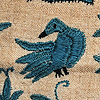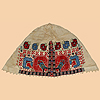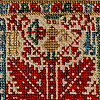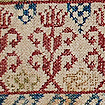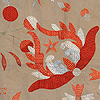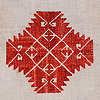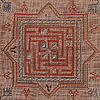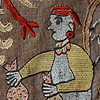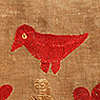Note:
Cretan embroidery is distinguishable from other Greek island embroideries by its large variety of colors and the use of a wide array of different stitches within the same textile. Whereas works from nearly all other Greek islands employ only one or two types of stitching in one piece, Cretans executed their embroideries with a mixture of feather, herringbone, satin, knot, chain, stem and other stitches. Based on their color palette, Cretan embroideries can be divided into two categories: polychrome and monochrome. Embroideries in the monochrome style can be characterized by the use of a single color, which is most often red or dark blue, whereas those belonging to the polychrome category, such as this lot, employ a large variety of color. The density of the design and the complex arrangement of interconnecting individual 'scenes' are also hallmarks of this latter group and are well exemplified in this coverlet. The large format of this embroidery further lends itself to a highly intricate composition, which can be only partially achieved when attempted in smaller textiles, such as towels or articles of clothing. Some of the individual motifs incorporated into the composition, such as the double-headed eagle and other fantastical birds, derive from Italian Renaissance prototypes and their use in embroidery dates back to the period before Crete was conquered by the Ottoman Empire in 1669, when Veniceruled the island. This lot was most probably part of a suite of embroideries to decorate a bed, see Krody, Sumru Belger, Embroideries of the Greek Islands, Washington, D.C. 2006, p. 28. Beds were among the most prominent furnishings in the Aegean household and were often lavishly dressed to show the wealth of the family and to exhibit the abilities of its female members as embroiderers and therefore good housekeepers. The embroidery suite would include a bed cover, pillow cases, valances and curtains fastened above and around the bed. The tradition of using lavish bed covers and curtains is not unique to Crete or the Greek Isles and it can be found throughout Europe, however it is uncertain whether this custom was introduced by the Venetians or their predecessor, the Byzantine Empire. A detail from a related example with the Textile Gallery was illustrated Hali issue 98, p. 147, fig. 16.
